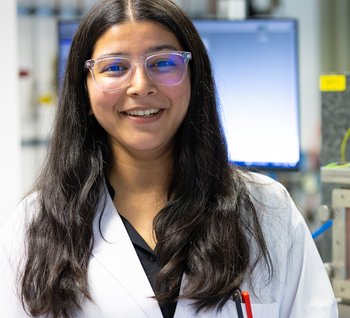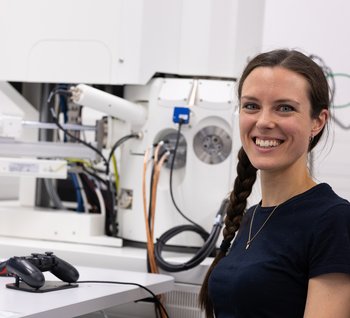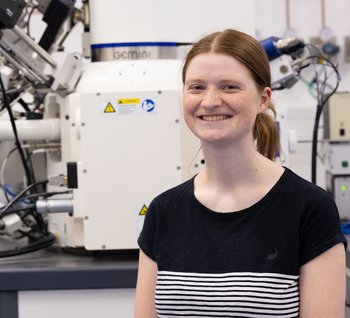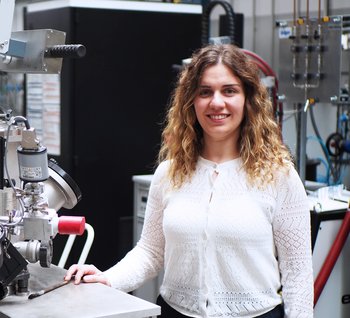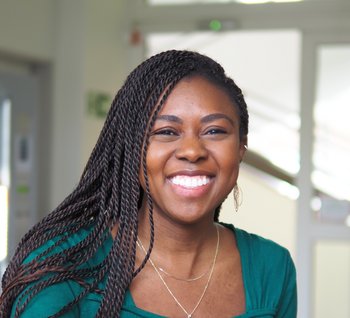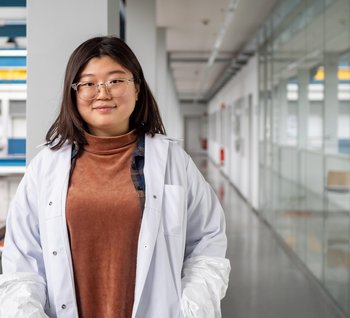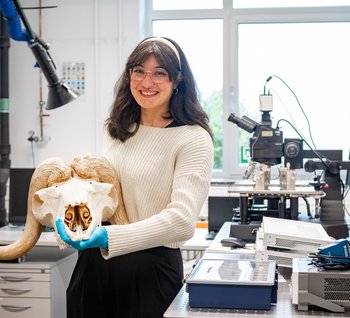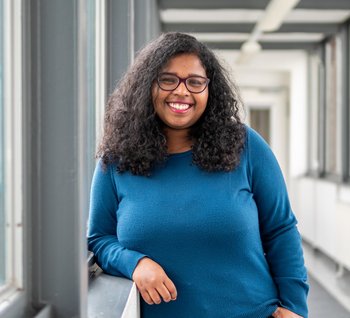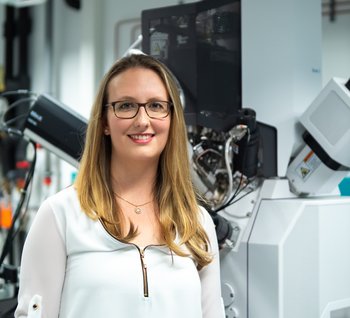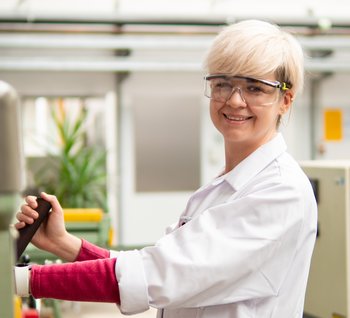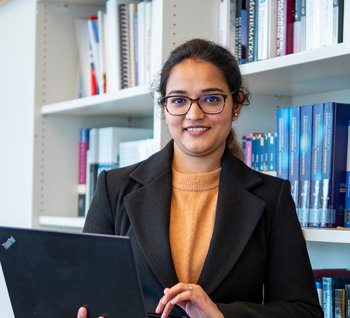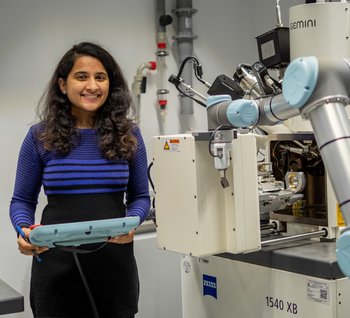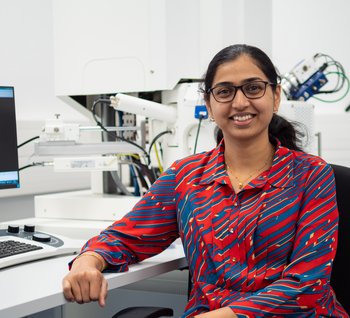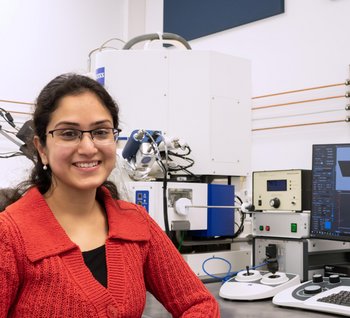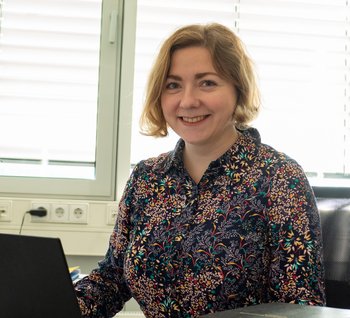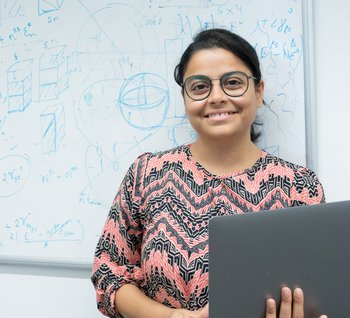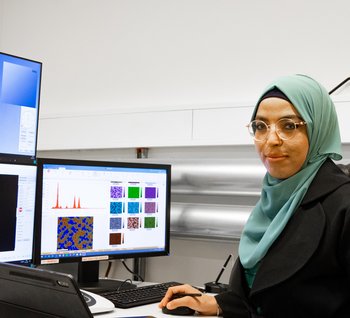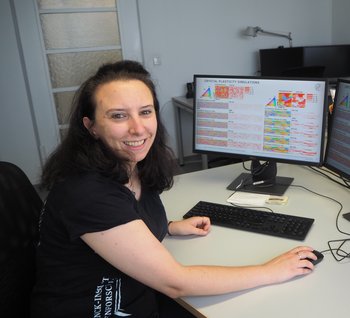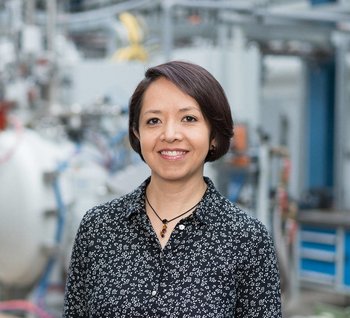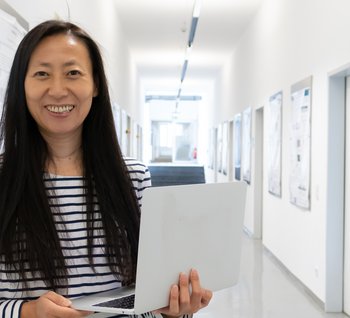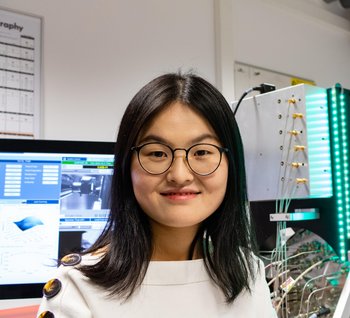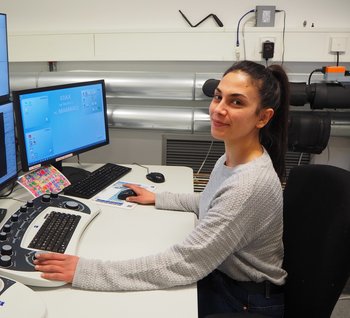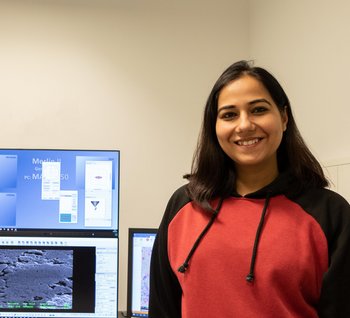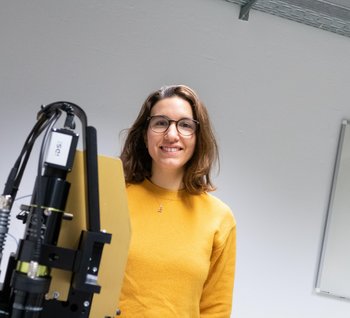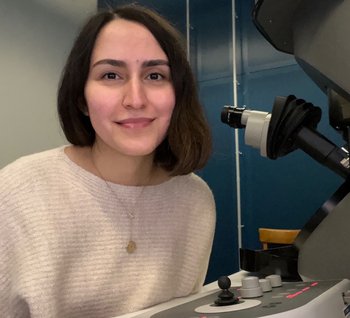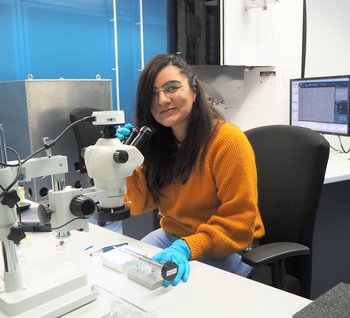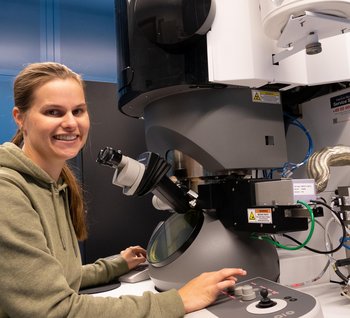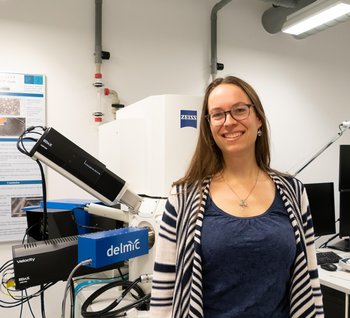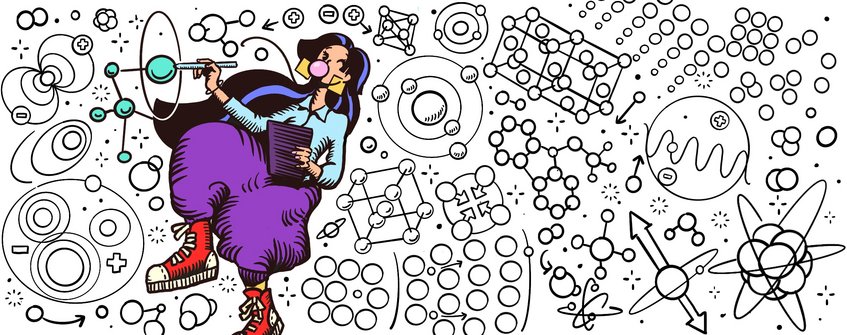
Women in Science
Men with wigs, men with beards, hardly any women. When you think of famous physicists, chemists or other natural scientists, images of men come to mind. We all know Newton and Einstein. Rightly so. But rather less Donna Strickland, who further developed the laser and was awarded the Nobel Prize in 2018. The first woman since 1963. Who knows Ada Lovelace, the software pioneer who formulated the principles of computer science as early as the 19th century? Or Stephanie Kwolek, the woman who developed Kevlar, which is nowadays used in bulletproof vests.
The Max Planck Society is committed to advancing women in science and offers a wide range of support services. And despite all the progress that has been made in recent years, there is a lack of women in science as inspiration for young female scientists. That's why we want to introduce female researchers working at MPI-SusMat: How did they get into research? What are their motivations and who are their role models? Which advice would they give to female pupils and students who consider going into research?
For Charu, the decision to pursue a research career started in school, inspired by her chemistry teacher, who created her interest for chemistry by showing lab experiments that made Charu wonder why things are happening like they do. Later, her mentor during her bachelor studies was also a woman: “She is the best person to have as a very first supervisor. She supported me scientifically and personally and even gave me feedback while I was applying for the PhD position at MPI-SusMat”, explains Charu. Later, strong mentorship, both from women and men, guided her academic journey and even sparked her interest in corrosion science.
She chose MPI-SusMat for its collaborative and supportive environment. “Here, no one is left alone. We openly discuss problems, share solutions, and my supervisor is always approachable. Plus, my project combines fundamental research with industrial applications, which was important to me.”
Her advice to aspiring scientists? “Good things take time and never stop believing in yourself. The best view comes after the hardest climb – something I learned growing up in the mountains of India. Don’t be afraid to try. There will be moments of self-doubt, but you have to overcome them. My mother, my ‘iron lady,’ taught me not to care too much about what others say and to follow my own path.”
She chose MPI-SusMat because it allowed her to combine her expertise in thermal conductivity imaging with state-of-the-art microstructural and chemical analysis tools. “Here, I can couple the thermal conductivity imaging techniques I worked on before with high-resolution electron microscopy to really understand how the microstructure and chemistry affect thermal conductivity,” she says. Her path to Düsseldorf was also shaped by her former postdoc advisor and an MPI-SusMat alumni she had met earlier, who both encouraged her to take this step. A Marie Curie fellowship provided additional motivation to grow her previous work at a place where she could deepen and expand her research.
Surprisingly, her path into science was not obvious at first. “In school, I liked literature and social sciences just as much. I just liked learning,” she says. It was her father who fostered her curiosity, even though he wasn’t a scientist himself. Eleonora’s father had a scientific mindset and encouraged his daughters to ask “why”. As a child, he always bought scientific children’s magazines about sustainability and climate change, which left a lasting impression. Later, Eleonora decided to study energy engineering to contribute to solutions for a more sustainable future. During her bachelor’s and master’s degrees in energy engineering, she realized she preferred the basic research over hands-on engineering, which led her to focus on thermoelectric materials for her PhD.
When asked whether she had a female role model in science, she reflects: “While growing up, I didn’t really notice how I was treated as a woman and didn’t have a role model. But during my postdoc and here at MPI-SusMat, I had women supervisors who showed me how you can do great science while maintaining a healthy working environment as well as work-life balance. That was and still is inspiring.”
Having joined MPI-SusMat just two months ago, she is part of the Hydrogen Mechanics and Interface Chemistry group and enrolled in the interdisciplinary IMPRS SusMet doctoral program. “I really appreciate the exchange with people from different disciplines. That’s why I decided to join the SusMet program”, she explains.
Her path into materials science started at RWTH Aachen University, where she completed both her bachelor’s and master’s degrees. “In school, I liked both chemistry and physics, but couldn’t decide, thus materials science seemed like a good mix,” she recalls. During an Erasmus exchange year in Norway, she noticed how differently the field can be approached: “In Norway, the focus was much more on nanotechnology and catalysis, while in Germany it was more into engineering and physics. That broadened my perspective.”
When asked why she decided to pursue a PhD instead of going straight into industry, she smiles: “I’ve always been curious about basic mechanisms. In school, I was a bit of a nerd, always interested in how things work. I felt that a PhD would let me deepen my knowledge before applying it.”
Role models? Not exactly. But she grew up in a family where science was part of everyday life: Clara’s father is a medical doctor, her mother a professor of physics. “I didn’t really understand what my mum was doing until I started studying myself,” she admits. “She showed me that I was capable and shouldn’t be afraid of it.”
Her advice to girls considering a career in science is clear:
“You can learn anything if you study for it. Don’t assume it’s too complicated - if you think you can do it, you can do it.”
“The beauty of working in fundamental research is that you have the freedom to explore, but at the same time, what we do here has a direct connection to real-world challenges,” she explains. “When people hear that I am working on green steel or material recycling, they immediately see the relevance. That’s a great motivation.” Her research focuses on green steel production as steel alone contributes to around 8% of global CO2 emissions. To mitigate carbon emissions, Tuğçe and her colleagues use hydrogen plasma to reduce iron oxides instead of carbon, thus making the process CO2-free.
Beyond the research itself, Tuğçe values the international environment at MPI-SusMat: “You meet people from all over the world, exchange ideas, and see different perspectives. It’s a colourful and inspiring atmosphere.” Discussing ideas with brilliant colleagues makes the everyday challenges of research more rewarding. And there are challenges. “Not every day brings a groundbreaking result,” she admits. “Sometimes, experiments don’t go as planned. But no experiment is a failure—you learn something each time.” It’s a mindset captured by one of her favourite Carl Sagan quotes: “The obvious is sometimes false, the unexpected is sometimes true in science.”
When asked about role models, Tuğçe immediately names Marie Curie. “She wasn’t just the first woman to win a Nobel Prize—she won two, in two different fields. But what really inspires me is how she never gave up. She worked under incredibly difficult conditions and dedicated her life to science.” While Tuğçe is grateful that she hasn’t personally faced gender-related challenges in her career, she acknowledges that many women in science do. “I was lucky to always have support from my family and mentors. But I know that’s not the case for everyone.” For young scientists, her advice is simple: “Be patient. Science isn’t just about big discoveries—it’s about the process, the everyday effort. Keep going, and eventually, things will fall into place.”
Selase’s academic journey took her to the University of Virginia, USA, where she studied nanomedicine—a field at the crossroads of materials science, biomedicine engineering, and chemistry. She then pursued a master’s degree in materials science at the University of Leeds, UK. Her career path hasn’t been without detours. Selase has worked in medicine, the transport infrastructure and the semiconductor industry. “In medicine, I wanted to help people, but I didn’t feel the same passion. Semiconductors were different—your impact is tangible, and with the right company, you can apply science flexibly. But no matter where I go, I always feel pulled back to research,” she explains. “One of my previous supervisors, Stephen R. Sharp, was a huge influence,” Selase says. “He was a nerd in the best sense—completely passionate about materials science. That enthusiasm rubbed off on me and solidified my path into research.
In 2022, Selase joined the MPI-SusMat, focusing on materials for biomedical implants. Using atom probe tomography (APT), she aims to enhance the nanoscale composition of common implant materials, improving their medical applications. “I came to Germany to focus on research unlike the US universities where I’d have teaching and other administrative responsibilities. MPI-SusMat caught my eye because of Baptiste Gault’s work in expanding APT into new fields like medicine. It’s exciting to contribute to such a groundbreaking endeavor, even if there’s a steep learning curve,” she shares. At MPI-SusMat, Selase found more than just scientific inspiration. Her first mentor, Ingrid McCarroll, became a role model in resilience and advocacy. “Ingrid cared deeply about the science but also stood up for other people. She stayed true to her principles in a male-dominated field, which was incredibly inspiring,” Selase reflects.
When asked what she would tell her younger self, Selase doesn’t hesitate: “It’s not a man’s world. You’re not the only girl—keep going, and you’ll inspire others to join you. Furthermore, most people don’t think of science as fun, but it’s taken me around the world and broadened my horizons. Science is a fantastic opportunity—embrace it!”
After completing her Bachelor’s degree and Master’s degree, Yeeun joined MPI-SusMat in Düsseldorf. Her research focuses on the sustainable production of green hydrogen using innovative catalysts, involving the synthesis and characterization of materials with advanced transmission electron microscopy. "I joined MPI-SusMat for three main reasons," Yeeun explains. "Firstly, sustainability is a major issue, and I'm proud to contribute to this field. Secondly, hands-on material synthesis is fascinating and makes the research more tangible. And last but not least, I was drawn to working with Professor Christina Scheu."
The influence of supervisors can significantly shape one’s experience in the scientific field. "During my Bachelor's in South Korea, professors in science and engineering fields were almost all men. While it’s not personal, men and women often have different perspectives and challenges. Sometimes men might have a blind spot for specific issues women face. Thus, having a female supervisor was something I really looked forward to. From day one, Professor Christina Scheu made me feel welcome and always provided a supportive ear."
Yeeun draws inspiration from both scientific pioneers and female writers like Virginia Woolf, a 19th and 20th-century English author known for challenging societal norms and becoming a symbol for women's and LGBTQ rights movements in the 1970s. "'A Room of One’s Own' is my favorite book. In it, Woolf argues that women need their own room and financial independence to be truly free. I think it's still a challenge we face in pursuing our dreams," Yeeun notes. Her advice to aspiring female scientists? “Don't overthink your decisions. Planning is important, but overanalyzing and being constrained by societal norms can stifle your true passion.”
Throughout evolution, animals and humans have adapted to their environments in incredible ways. How do animals protect themselves from extreme weather conditions or why are elephants nearly immune to cancer? Genna’s fascination with these natural phenomena sparked her interest in medicine and biology early on: "I've always been intrigued by medicine and biology, but math was a big hurdle in school. Maybe it's a common thing for girls to convince themselves that math is too hard," Genna reflects. But instead of letting this hold her back, she doubled down: "I had to step up my math game in my final year of high school to pursue biomedical engineering. Once I got to university, I realized high school math was just a warm-up. Pushing through those challenges, I ended up really loving it."
From Galway to MPI SusMat
Genna grew up and studied in Galway, Ireland, before joining MPI SusMat in February 2024. Her research project here is unique: She’s studying a muskox skull. Muskoxen roam the Arctic tundra of Greenland and Alaska, and the males, weighing up to 400 kilograms, engage in head-butting contests during the rutting season. They smash their heads together at high speeds, up to twenty times in a row. "Despite these brutal collisions, they only suffer minimal brain damage," Genna explains. "We’re investigating the materials in their skulls, from the nano- to the meso-level, to uncover their architectural, chemical, and mechanical secrets. Our goal is to inspire the design of new materials with extraordinary energy-absorbing properties for example for aerospace or automotive applications."
Genna’s path to materials science was somewhat unexpected. "I knew about the institute, but my background was mostly in working with bones. This focus on materials science is new to me," she shares. "I saw the job posting on LinkedIn and thought, 'I have to apply.' Even though I had no experience with imaging techniques like transmission electron microscopes, I got the position. The warm welcome and training I received here have been invaluable. It’s the perfect blend of applying my knowledge and diving into something new."
Following your passion
Genna believes that societal norms can shape interests and career paths from an early age, often causing girls to lose interest in natural sciences. "There’s so much potential out there but it is lost. People should pursue what truly excites them, not what others expect," she says. Reflecting on her journey, Genna draws inspiration from two important women in her life. "Scientifically, Jessica, a postdoc during my PhD, was a huge influence. Despite being incredibly busy, she always took the time to train me. My mother is my general role model. She always wanted to pursue design, but followed her family's expectations instead. When I was around 10, she went back to college to study interior design, juggling kids, coursework, and projects. Now she has her own interior design business. Her story shows it's never too late to chase your dreams."
From Siegen and Munich to Düsseldorf
In 2019, Ankita moved to Germany for her Master’s studies: "I wanted to experience something different outside of India. I knew I wanted to go either to Germany or the Netherlands because of their excellent fundamental research," she explains. She chose the University of Siegen: "I didn’t know German well, so Siegen was perfect because they offered many courses in English. Plus, the university’s hilltop location had stunning views." After a six-month research stint at the Technical University of Munich, Ankita applied for a PhD at MPI SusMat. She was already impressed by the institute’s scientific reputation, and meeting her future group leader, Dr. Martin Rabe, sealed the deal: "He was so passionate about his project, and his enthusiasm was contagious. That was really important to me. It wasn’t just about scientific prestige; it was about working with inspiring people. Plus, Düsseldorf’s vibe suited me well. Coming from a big city like Pune, the adjustment was easy."
At MPI SusMat, Ankita studies biomolecules like proteins and how they adsorb on different germanium surfaces. Germanium is known as a "smart surface" that changes its properties with certain electrochemical triggers. The applications aren’t clear yet, as it’s crucial to understand the adsorption process and the properties that can be derived from it: "I love this fundamental research approach because it allows for experimentation in many directions. Coming from a chemistry background, playing with these molecules is fantastic. With all these advanced microscopes, I can now produce images of particles down to the nanoscale. The kind of images I used to be fascinated by as a child."
Do what you love and push through
The downside of fundamental research is its unpredictability. You never know what your results will be, and it can be frustrating when things don’t go as planned. But these challenges lead Ankita to two key pieces of advice for young women interested in science: "First and foremost: Do what you love. Push through the initial frustrations of experiments, and you'll soon get a clearer picture. Secondly: Find your role model. Historically, men have often taken credit for women's discoveries, but this is starting to change. There are many great female role models out there, and if you can’t find one, you can always become one yourself."
In the 1990s her parents moved from Romania to Fürth, Germany. She reflects on her upbringing, saying: "My parents came from a simple background, living in a rural part of Romania. The idea of attending university or pursuing a career in research seemed utterly out of reach at first." Kloos educational journey began in secondary school ("Hauptschule"), and from there, she gradually ascended the educational ladder, progressing through various German school types, from business school ("Wirtschaftsschule") to technical school ("Fachoberschule"), ultimately attaining her Abitur.
Kloos’ key moment occurred during a visit to the Night of Sciences in Erlangen, accompanied by her uncle. At the Friedrich-Alexander-Universität Erlangen (FAU), she was exposed to her first encounter with material science experiments and electron microscopes. She was captivated. At that moment, she made a resolute decision to pursue a career in this field, despite the obstacles she faced: "I struggled with math, battled exam anxiety, and required additional tutoring after school. My school didn't offer courses in physics or chemistry. Nevertheless, I was determined to excel in math and told myself that I would attempt studying natural sciences. Failing was the worst that could happen."
Kloos began her journey at the FAU, studying nanotechnology in her bachelor and materials science in her subsequent master's studies. Without prior exposure to chemistry or physics in school, beginning university posed a significant challenge: "The initial semesters of my bachelor's program were hard. Everyone else had at least a basic understanding of chemical reactions and equations of motion. Everyone else completed their homework faster than I did. Consequently, I invested extra time in self-study, reading books like 'Physics For Dummies' to catch up on what I had missed in school."
Upon completing her master's degree, Kloos sought new opportunities and, as fate would have it, crossed paths with Prof. Christina Scheu, group leader at MPIE, during a symposium in Erlangen. Kloos elaborates: "I had always aspired to work in micro- and nanostructural analysis. The possibility of using microscopes to visualize individual atoms still holds a sense of wonder for me. Furthermore, Christina’s focus on renewable energy aligned perfectly with my interests. Securing this position at MPIE remains somewhat surreal. I recall that during my bachelor's years, my friends and I would often dream about working here. We admired the researchers, though it seemed like a distant dream. Now, I find myself here alongside some of my colleagues from those early years."
In early 2023, Shelyug joined MPIE through a Humboldt scholarship. Her current focus lies in the improvement of metal yield from hydrogen plasma reduction process. Regarding her work, she explained: “To understand how to make the metallurgical processes efficient and industrially interesting, I'm acquainting myself with the tools at my disposal, such as the arc furnace. In other words, understanding the effect of various experimental conditions on hydrogen plasma through its reduction ability. At the moment, I'm producing numerous samples to optimize the metal yield while minimizing energy and resources expenses. Essentially, I'm varying the plasma parameters each time to determine the amount of metal extracted. It may seem simple, but it's an essential prerequisite for what lies ahead: Understanding the fundamentals of plasma-material interactions. Such a study is important not only for the applications in metallurgy sector, but for the area of fusion energy where hydrogen plasma causes detrimental changes to the construction materials upon interaction."
Balancing career and personal life
For Anna Shelyug, embarking on a research career isn't determined by one's gender, but rather by personal motivation. She believes it's crucial for parents to introduce scientific concepts to their children and treat them equally, irrespective of their sex or gender. She asserts, "Every individual has the right to become who they aspire to be, not confined by societal expectations." Consequently, Shelyug doesn't have a specific female role model but draws inspiration from researchers who successfully balance their research pursuits with their personal lives outside of work: "Achieving this balance remains a tough challenge, particularly for women with children. Some choose to leave their jobs and embrace motherhood, while others continue working or opt not to have children at all. I've witnessed women taking various paths. The crucial factor is that they have the freedom to make life choices that aren't dictated by their families or gender roles. If one regrets quitting or not quitting, it's still possible to alter their plans."
Shelyug understands from personal experience the difficulties of managing both personal and professional aspects of life: "My husband is incredibly supportive of me. Nevertheless, since we both work in the same field and aspire to advance our careers, it requires ongoing negotiation regarding job commitments and our living arrangements. And despite marriage is usually assessed as a search for a compromise or even some sort of sacrifice, I firmly believe that everyone's needs can be fulfilled; it's just that sometimes the path to it may not be apparent in the present moment. "Looking ahead, Shelyug envisions seizing new opportunities that come her way and continuing her scientific journey. She recognizes that embracing these experiences can pose challenges when it comes to organizing one's life, but she emphasizes their tremendous rewards. Not only do they contribute to scientific growth, but they also foster personal development. She concludes, "I highly recommend pursuing such experiences to everyone. They can be transformative, not only in terms of scientific progress, but also in shaping one's character. It's an aspect of personal growth that should not be underestimated in your development.
After her master degree, Bhatt worked as a research assistant at the Karlsruhe Institute of Technology (Germany) in the field of molecular dynamics and later at the German Aerospace Center on thermoelectrical transport materials using density functional theory (DFT). Gathering first experiences abroad and applying her knowledge to application. Bhatt joined MPIE via the doctoral program SurMat and works in the research group “Defect Chemistry and Spectroscopy” on orbital contrast in Field Ion Microscopy (FIM). FIM is a relatively old technique, but can deliver important insights when combined with newer methods: “FIM allows to picture single atoms on a surface, allowing us to visualize defects or impurities. Specifically, we image ionization contrast that arises from the electronic structure of the imaged surface. Combined with DFT calculations, we work on understanding these chemical contrasts on alloy surfaces and match our simulations with experimental results”, Bhatt explains.
Working better together
Most scientific challenges are not solved in a few minutes or hours, but rather months. However, this process of learning and always trying something new is part of Bhatt’s fascination in doing research, as she explains: “Research, in the first place, is not about earning some degree or money. It is about learning. It is great when your simulations work out and even better when you can contribute something to the welfare of society. But it can be likewise fruitful if something does not work right away.” At MPIE, she found a working environment that supports not only her scientific focus but also her learning ambitions: “You do not sit alone in your office all day. Especially my department encourages coming together and sharing work and ideas. Every week we organize hackathons and meetings where we come together with our different projects, problems, questions and suggestions. I never experienced such a nice working environment before. The way work is done here made it very easy to accommodate at MPIE”, she explains.
Although problems and ideas are discussed collectively, your own motivation is crucial: “You need to be hungry for information and eager to learn new things. If you are hungry, everything looks like food and you stay willing to explore new paths. Even better if you have family, friends or partners who support you in your path.” Someone who walked her path and inspired Bhatt is the physicist Marie Curie: “Without fancy labs, she won two Nobel Prizes and tragically sacrificed her life for her research on radioactivity. Thankfully, nowadays we have better safety standards, but Marie Curie, her effort and dedication remain unforgettable and inspiring for me.”
Implants and robotic arms
In 2021, she joined the department of Microstructure Physics and Alloy Design at MPIE to work in the area of metal additive manufacturing. Her research is about developing 3D-printed low modulus titanium alloys for biomedical applications. “Compared to stainless steels with high stiffness, beta titanium alloys have lower elastic modulus (less than half that of steels). This low modulus allows for better adjustment to the existing bone structure by alleviating the stress-shielding effects, therefore, preventing implant loosening, premature failure, or potential bone loss. This feature can be further improved with 3D printing: “With 3D printing, we can reverse engineer a patient’s anatomy and print a customized part, which exactly fits their body and bone structure”, Tekumalla explains. To understand and improve the performance of 3D printed titanium alloys, you need to dig deep down into their complex and unconventional microstructures. Materials properties like the elastic modulus and fatigue behavior are influenced by the composition of this microstructure: “Usually we understand materials from their 2-dimensional cross sections by polishing the surfaces and performing microscopical investigation. Since additively manufactured materials have really unusual microstructures, having a 3-dimensional perspective can give complete insights into the microstructure and the complex thermal history undergone by the material. At MPIE, we have an in-house built fully automated 3D EBSD system which has a robotic polisher that polishes samples, and a robotic arm that places the polished samples into the microscope to get images. When this process is repeated 200 or 300 times automatically, layer by layer, you get several 2-dimensional maps which can then be reconstructed to a 3-dimensional dataset that is a true representation of the full microstructure. That’s really impressive and helps us get reliable and easy-to-interpret results. Furthermore, automation saves us time and effort in preparing samples by hand.”Experience is key
Gaining practical experience is something Tekumalla recommends to anyone who thinks about going into research: “Research is greatly rewarding and requires a great deal of patience, especially in a research field that has so many possible applications from cars or buildings to medical implants. To know if research is your cup of tea, start with a short research stint and get a feel for it by gaining some practical research experience. For example, by taking up research projects with professors in universities or at research institutes. With all the advancements and still many unanswered questions, it is a great time to be in a research setting!”
In 2022, Sonawane joined MPIE with a Humboldt Scholarship to work on iron aluminides: “When I planned to apply for Humboldt fellowship, MPIE was my first choice for the host institute. There was no second thought about it. I had followed their papers, particularly their work on small-scale mechanics. Moreover, the experiences of some seniors who spent time at MPIE and state of the art facility available to conduct my research here only reinforced my decision”, she says. Iron aluminides have promising applications in the aerospace industry. Iron is abundant and aluminum light-weight. Alloys made of iron and aluminum are strong and corrosion-resistant thus, promising candidates to work under the extreme conditions of airplane turbines. At the same time, it is still unclear how their mechanical behavior changes, when subjected to extreme loading conditions of high temperatures or high strain rates. Therefore, Sonawane is investigating the micro-compression of iron aluminides using a dewetting technique to design a high-throughput testing route: “Every small change in the alloy composition, changes the alloy’s properties. Preparing traditional samples needs a lot of time and material. We, therefore, prepare thin films of iron aluminides, followed by dewetting them to form microparticles which are then subjected to mechanical characterization under high temperatures and high strain rates. This method is promising in delivering accurate, high-throughput micro-mechanical testing”, Sonawane explains.
Sometimes experiments fail or do not deliver useful results. Therefore, perseverance and self-motivation are two of the most important character traits a scientist should have. As the Indian-born American astronaut Dr. Kalpana Chawla once said: “The path from dreams to success does exist. May you have the vision to find it, the courage to get on to it, and the perseverance to follow it.” This attitude and the quest for learning new things motivated Sonawane to continue her journey in science: “To the girls who want to pursue a career in science, I must say that your motivation has to ultimately come from within you. You might face setbacks on this path but your patience and passion will keep you focused. Also, throughout the journey, there are always people who will inspire you. For me, everyone I met who encouraged my journey and taught me new things is a role model - my school/college teachers, Ph.D. and postdoc advisors, and also my husband now. They strengthened my determination to follow my dream.”
Connecting the micro- and macroscale
At MPIE, she studies magnesium alloys that are widely used for light weight automobile parts. Kanjilal aims at understanding the micromechanics of fracture in brittle intermetallic phases in magnesium rich alloys: “The micron size intermetallic phases dispersed in these alloys strengthen it. At the same time, crack formation in these phases can lead to failure of the component during service. Understanding more about the processes and properties of these intermetallic phases can help develop more resistant and safer materials.” explains Kanjilal. She performs fracture tests of microscale specimens of these intermetallic compounds guided by in-situ loading inside the microscope: In-situ testing can be a powerful tool to link the local microscale response to the global macroscale behaviour of a material. It is exciting to actually see what is happening during the deformation of materials at the microscale in real time. Now that I am working here, I have the opportunity to perform such experiments using state of the art experimental facilities and exchange with excellent scientists. Pursuing my postdoctoral research here at the institute is something I am really happy about.” Additionally, by extending the fracture experiments to elevated temperatures in conjunction with post deformation microscopic analysis, she tries to understand the role of temperature mediated plasticity on crack propagation and failure and its effect on the fracture toughness of these intermetallic materials.
Understand more to fear less
Science never “stops”. There is no point where everything is known. Although research gives us answers, it is always open-ended and provides you with further research questions. So, todays generations of scientists can build on the work of the generations before: “I consider myself very lucky to be part of a family where two of the closest women in my life—my mother and my sister—have pursued a career in academia. Their determination and encouragement have motivated me to follow the path of science and continue to do so even today. I am sure that if you are pursuing a career in science you will also become a role model and inspire more daughters and sisters out there. As the famous quote by Marie Curie goes: "Nothing in life is to be feared. It is only to be understood. Now is the time to understand more, so that we may fear less.", says Kanjial.
She joined MPIE in 2021 and is working in the Computational Materials Design department. The atomistic simulations reveal the behavior of different lattice defects in metals and alloys. Smirnova is working on Ni-based superalloys, which are for example used in turbine blades and are developed to maintain prolonged durability and strength at high temperatures. Understanding the defects in the material is an important groundwork these alloys. This fundamental research has its own merits, as Smirnova describes: “Fundamental research, by itself, is a unique combination of rather specified practical tasks, fundamental basics of the discipline, and creative working. The most exciting thing is, that a piece of your work, being prepared and published, may sooner or later find its place in a whole puzzle of knowledge and further be used, or resonate somehow in other way with completely independent research.”
A scientific career can offer many valuable experiences and possibilities: “I am especially happy to see that the natural sciences are less and less considered a male dominated sphere. So, if you feel interest and curiosity, find a field that encourages you to search for answers. This not only provides your research basis, but gives way to interactions. And interactions are the most valuable in science. People from all over the world come together and you have high academic mobility through conferences, exchange programs and international grants. This is something great and really beneficial to your career.”
As an undergraduate, Chakraborty was drawn towards physics and mathematics. It felt like connecting the pieces to complete a puzzle: “I knew I wanted to do research in physics, initially in theoretical physics. However, now I feel more motivated to work with topics related to current issues of our time. It has been an age-old problem to understand material properties to minimize the detrimental effects when they come in contact with environmental elements such as hydrogen. I work on aluminum alloys, which are widely used in the aerospace industry. Therefore, my work is extremely important in terms of safety,” says Chakraborty. Hydrogen can dissolve in most metals and alloys, and its interactions with the crystal lattice are detrimental in e.g. iron, steel, nickel, zirconium, and aluminum. During her Ph.D. she studied the effect of hydrogen in zirconium and zirconium hydrides. The results were promising and had many interesting openings, which needed further investigation. After joining MPIE, she started a systematic evaluation of various types of metal-hydrogen interactions in crystal structure and at interfaces of defects. Her atomistic modelling helped to understand that specific metallic solutes in alloys might be useful in decreasing the detrimental effect of hydrogen in aluminum. One study on zirconium and hydrides revealed that solutes may enhance defect formation that play an important role in understanding the overall performance of an alloy during its use.
As a postdoctoral fellow at MPIE, Chakraborty commented on her experience: “MPIE facilitates accessibility to more people (across disciplines) and equipment than would have been possible otherwise. The collaboration and communication in between the departments are a very unique feature of MPIE. One gets to learn from so many experts in one place. Looking at a problem from the perspective of all these different fields is the most useful way to come up with a holistic solution.” On her position here, Poulami noted “I have independence to work on interesting scientific questions that really matter to me. The research groups that I primarily work with (Baptiste and Tilmann groups) also encourages me to independently explore my ideas.”
One of Chakraborty’s role models is the mathematician Emmy Noether. In a time when women were not allowed to habilitate, she became one of the most profound mathematicians with her theorems in theoretical physics laying the foundations of modern physics. Although the situation of women in science improved since then, there is still a gap between women studying and being professors or leaders: “It is still a challenge, especially when women start having families. But there are opportunities for support and I think we should use them. And to any women interested in science, give it a go, give your best and do not let anyone tell you it is too hard, complicated or scary. Science is challenging, but this is also what makes it interesting and fun. We always need more role models, so be that role model.”
Abu-Muhfouz is working in the “Microscopy and Diffraction” research group at MPIE. She is using correlative electron microscopy and atomistic simulations to study β-FeSi2-based polycrystalline thin films. These films are used for photovoltaic applications necessary to build a sustainable future: “To understand the materials and develop them further we need to understand the microstructure formation mechanisms and their functional properties. This is what we are working on using the advanced methods at hand here at MPIE”, explains Abu-Muhfouz.
The state-of-the-art research was what motivated her to join the institute. The well-equipped laboratories, cutting-edge technology and passionate research departments. But at MPIE she found more than that: “Beyond the equipment and the technical stuff I found support here, I found friendship, outstanding colleagues and meaningful research. That is the core of MPIE”.
To pursue a scientific career, you need to know yourself and what you want very well. And there are some things Abu-Muhfouz would recommend young women who want to go into science: “Don’t limit yourself. Be aware of and appreciate every single phase, be it fails, obstacles or successes. Not limiting oneself also come with planning your options early. Like joining scientific societies, participating in competitions or voluntary social works. Because as Paul Brandt impressively said: “Don't tell me the sky's the limit when there are footprints on the moon!””.
Dr. Elisa Cantergiani’s fascination for science already started in school where she was curious how nature worked: “When it was time to choose the university, it was kind of logical to choose a path in science or engineering. Materials Engineering had a balanced mixture of physics, chemistry and industrial applications”. After graduation, she worked in the automotive and packaging industry for five years before going back into research and pursuing her PhD. Now Cantergiani is working as a postdoctoral researcher at MPIE in a project on aluminum: “From the beverage cans to automotive and aircraft parts, aluminum is key for modern industry. I am working to optimize its texture and microstructure, so it can be more formable thus more useful for applications” she explains. Cantergiani performs crystal plasticity simulations to predict the microstructure and texture evolution as well as how to optimize the material during hot and cold rolling.
Her fascination for research goes back from her will to understand the world and take new paths to achieve this understanding: “In research and engineering, it is very exciting to walk on knowledge paths that nobody has ever tried before. It can be also frustrating because when something new is started and nobody has done it before, you can do many mistakes. But here comes perseverance into play. In the end you will be rewarded with satisfaction and being the first in trying something new. This is what makes up the excitement.” The same can be said as advice for young women considering a career in research: “Believe in yourself, your skills and hold on, even if a project does not go as planned or you find yourself working in an environment where women are under-represented. As a woman working in men dominated environments, sometimes you feel you have to prove yourself more than your male colleagues. That’s difficult, but also trains you in following your goals no matter what.”
A symbol for resilience and perseverance
Some inspiration for this way comes from one of Cantergiani’s scientific idols, the Italian neurobiologist Rita Levi-Montalcini: “She is an example of perseverance, passion and resilience in life. Despite the anti-Jewish laws enacted during fascism in Italy at that time that prevented her to access research laboratories in universities, she still kept her strength and motivation. She built up a small lab in her bedroom to keep doing research in biology and medicine until she was able to immigrate to the US, where she developed most of her career, finally receiving a Nobel Prize in medicine in 1986.”
Research for Duarte becomes especially relevant, when it is put in to the service of the people: “Science has improved our quality of life with every new discovery. Improvements in medicine help us to live longer and healthier. Improvements in electronics allow us to connect with people around the world and improvements in structural materials make longer flights without the need of refuelling mid-flight possible”, says Duarte. With all these advances in mind she also sees the protection of the environment as a service to the people. Every scientific improvement therefore needs to be considered through the lens of its ecological effects thus bearing a responsibility regarding future research.
Sustainability is a big topic at MPIE and one Duarte is also working on. Particularly the effects of hydrogen on the mechanical behaviour of materials. Hydrogen can be used as a clean energy carrier but also degrades certain materials leading to fracture. The goal of her and her colleagues is to use the understanding of hydrogen effects to design materials more resistant, sustainable and safe. Her insights may also be part of a bigger picture assembled by generations of scientists to come: “Of course in this future generation of scientists we also need more women. Science can be so much fun when approached with an open mind for discovery and learning. I can only say to girls who are curious about science: Approach female scientists you might know, at places like MPIE or science fairs. We are friendly people and open to answer all your questions.”
The core of the simulation methods she employs is parameter-free ab initio calculation based on quantum mechanics. Using this method, the macroscopic properties of materials can be explained from the level of chemical bonding. Ab initio calculations have been traditionally limited to a temperature of 0 Kelvin, “When going up to finite temperatures, the computational cost becomes extremely expensive even with modern computing power. The Computational Materials Design department at MPIE is a world leading team in methodology development. It has established a methodology to break the temperature limit. Now we can accurately calculate the solid free energy up to the melting point with high efficiency”, says Zhu. On top the development of phase diagrams is critical for guiding material design. However, such calculations based on ab initio have been hindered in the past two decades due to the extreme computational cost. To tackle this challenge Zhu has developed a state-of-art methodology for liquid free energy calculations, which combines significantly improved computational efficiency and ab initio accuracy by employing machine learning potentials. Besides these scientific developments, she is also involved in the Platform MaterialDigital: A nation-wide initiative to develop infrastructure and software solutions for sharing data, workflows and knowledge by taking novel concepts as well as industrial needs into account.
Alongside digitalization and big data, another hot topic accompanies Zhu in her career: Reconciling work and family life. Zhu herself gave birth to her now 8-year-old son during her Postdoc: “Having a career in science is challenging and competitive, especially for women with small kids. Therefore, time management and good organization skills become extremely important in order to make a balance between work and private life. However, one can get lots of practical support from our institute that is greatly helpful.” Despite these challenges, Zhu would recommend choosing the scientific path: “Personally, I feel that working in the scientific field can not only train one's working ability, but also sharpen one's will. As for me, I am especially happy that I have spent quite a period at MPIE. Not only its advanced research environment, but also the warm and human culture will be a lifetime treasure for me. And even if you eventually decide to leave the scientific field, you will still benefit from what you have learned for the rest of your life.”
Hydrogen embrittlement: Causes and how to avoid it
She is working in the research group “Mechanism-based Alloy Design” on the harm-causing effects of hydrogen in aluminium alloys: “As hydrogen is the smallest of all elements, it is extremely challenging to detect on the atomic scale. Thanks to the new cryo-transfer atom probe tomography developed at MPIE, we were able to map the distribution of hydrogen and understand its influence on the mechanical properties”, explains Zhao. But what about completely avoiding the damage hydrogen can bring to alloys? Manipulating the hydrogen trapping sites to mitigate embrittlement is one promising solution researched by Zhao and her colleagues. What she furthermore explores is the specific corrosion behaviour of aluminium to enhance corrosion resistance and improve sustainability of engineering materials.
Behind the data
Digging into the mechanisms behind experimental data is key for Huan Zhao’s passion for her field: “Tracking and trapping hydrogen in alloys is like being a materials detective. And every contribution to the field boosts your confidence, because it is one step closer to improving safety for people in their daily lives.”
Now the question is of course not what causes climate change, nor its catastrophic consequences but rather how to tackle it. We need to rethink our technology and way of life to reconcile our civilization with environment. One major topic has to be the production of steel - as without steel a modern civilization would not be thinkable: “The steel industry is very important but also the single biggest emitter of global CO2 emissions. So obviously we need new, more sustainable steel production”, explains Özgün. One possible alternative to the conventional steel production is the reduction of iron ores using hydrogen. This is well known, although some questions are still open that prevent the large-scale use of this technology: “The reactions of iron oxide with the impurities in the iron ore at the atomic scale are still not understood. However, this is a central question. Researching this question is my aim as member of our research group on Sustainable Metallurgy.”
A blind spot motivating Özgün. Not only because she is doing her part for the sake of fighting climate change as she explains: “One of the reasons that makes me highly interested about this research is, that the role of impurities in materials has been underinvestigated for a long time and there is no sufficient fundamental knowledge on this aspect.” And where to better research fundamentals than at the MPIE? “MPIE is a great institute that provides a good working environment with latest technology. Here is the best place for those who have a high curiosity about science!”, Özgün adds.
More questions waiting to be answered
There are still a lot of questions out there waiting to be answered by all those choosing the scientific path. Fundamental questions, which give us insights in natural processes or expand our problem-solving possibilities: “There is much to learn and much to uncover in the world around us. All young scientists need is curiosity and no fear to follow their dreams!”
She joined the MPIE as a postdoctoral fellow of the Alexander von Humboldt Foundation in January and is working in the department of Microstructure Physics and Alloy Design. Her study is mostly focused on green steel production. “Researchers all across the world are looking for strategies to reduce CO2 emissions. The steel sector accounts for 8% of global emissions, and this figure is expected to rise further. Given the critical nature of climate change, we urgently require industrial-scale sustainable alternatives.”, Devi explains.
Her main focus is the reduction of iron ore under hydrogen atmosphere. This reduction process is known and promising, but certain fundamental concerns remain, for example about the processes at the microstructural and atomic scale during the reduction. Devi and her colleagues want to address these concerns: “The current working idea seeks to comprehend the precise kinetics of direct reduction of iron ore pellets by pure molecular hydrogen, followed by the intermediate production of additional iron oxide types. The findings will provide microstructural and atomic-scale insights into the composition and phase changes that occur during iron ore reduction by hydrogen using environmental in-situ TEM (note from the author: TEM: transmission electron microscope) studies, paving the way for a better understanding of the thermodynamics and kinetic barriers of this critical process”.
One of the motivations for joining the MPIE was its reputation as Devi states that "the Max Planck Society is widely renowned on the international stage for solving several significant scientific subjects. They develop a unique atmosphere where perspectives and ideas may be shared crossing cultures and ethnicities. Furthermore, MPIE has provided a plethora of inspiring personalities who have demonstrated their dedication to research in order to uncover something new.”
Devi herself does not have any female scientific role model. At the same time, she certainly considers her mother as a role model. Her mother has no formal education, however recognizing the importance of education. She always encouraged and supported Devi in her pursuit of further education and scientific progress: “While embarking on an unchartered path like research, it is necessary to keep an eye on your goal. It is not necessary to be exceptionally intelligent in order to tackle any outstanding topic in research. It requires a great deal of patience and continuous effort, as there are more failures than successes, which are the greatest teachers", concludes Devi.
As technology advances there is a clear shift towards miniaturization as Bellón explains: “In materials sciences, there is what is called the size effect: The smaller the stronger, but even though this is known, there are still some gaps in understanding this in the context of extreme situations.” Therefore, Bellón's main research focus is to study the mechanical properties of nano- and microscaled materials in extreme conditions. Compressing different small-scale particles or pillars at very high speeds and through a wide range of temperatures. As not only the composition can impact materials' properties, but also the conditions to which they are subjected.
Her work is never the same, it is a continuous challenge, keeping Bellón busy. Finding the reasons for different behaviour, interpreting experiments, solving problems and creating experiments from scratch. And even if experiments do not work they still give her information about what is happening and she can test her ideas. Bellón appreciates this creative process and also the work environment at the MPIE: “Before applying here, I knew of the reputation and well name of the MPIE. I spoke with different colleagues that have worked here before or have tight relations with the institute and they recommend it to me. Here I can work independently but also together with colleagues in an international environment which is something I appreciate.”
In her scientific path, Bellón had no specific scientific role model, although meeting very amazing women in her career. In the materials department where she did her diploma thesis, the professors were only female and meeting more amazing women during her PhD inspired her to fight for what she wanted. This was something she learned from her mother, who has always been a great inspiration to her: “There is something my mom used to tell me: The one who wants is more able than the one who can. So don’t ever let anyone tell you what you cannot or should not do. That should come from your inner feelings." Bellón adds: "When you want to go into science I would also recommend to join supporting scientific women groups, where you can share your experiences and learn from others”.
She works in the independent research group “Nanoanalytics and Interfaces” headed by Prof. Christina Scheu. There, Changizi analyses lanthanide doped semiconductors. As a physicist she was always intrigued by the physics behind the light. The particles that she studies have light-producing properties which she tries to enhance even more. The detailed microscopes at the institute enable Changizi and her colleagues to investigate the materials on the nanoscopic scale and check how the atoms behave and change in different conditions and determine which conditions are most favourable for applications in industry.
Coming back to inspiring stories and personalities: A great inspiration for Changizi comes from her group leader Prof. Christina Scheu: “Working with Tina is very pleasant and always engaging. Her love and dedication for science is beyond words. And this passion and energy spreads to all her students including me. I hope that one day I can be a kind and caring leader like her.” Going into science not only offered a career path but also personal development: “Personally speaking, doing science really boosted my confidence. It gave me the wings to be stronger, patient and self-confident in everything I do. I believe for being successful and happy in life, one needs to develop these characteristics.”
What fascinates her most about her work? "Here at the institute, I get to work with state-of-the art microscopes, which is pretty cool. Thanks to MPIE, I'm one of the few people on Earth who gets to see aluminium structures down to the atomic level."
Her enthusiasm for science began in school. Her own interest in understanding how the world works and teachers who encouraged curiosity were her impetus to work scientifically, "What deeply impressed me when I was growing up was that science can help you make a real difference in society. It makes you feel independent and innovative." Consequently, her path into research continued to the Max-Planck-Institut für Eisenforschung. “It’s not only the institute's fantastic international reputation, equipment and interdisciplinary focus, but it’s also about the many inspiring people here who put themselves at the service of research to discover something new, potentially world changing.”
Her path to research is one that cannot be taken for granted when you compare today's world with the conditions 50 years ago: "My grandmother's generation was never allowed to study. My mother had to give up her studies when she got married to take care of the household. Now the world is changing around us, and science is the main driving force, especially technology. Today, there are so many exciting opportunities for women, especially in science." More flexible work schedules and supportive initiatives alleviate the challenges that prevent women in particular from pursuing careers in science, Saba added: "You can be involved in revolutionizing the world while having fun discovering new things."
Frommeyer's decision to work scientifically came during her master's thesis. A basic prerequisite for scientific work is the willingness to deal with a topic in a persistent and comprehensive manner. An additional attraction is the opportunity to analyse something that has not yet been researched and to gain new insights. After reading some of the MPIE's publications during her research for her master's thesis, an event at the institute offered her the opportunity to do her doctorate here: "Not only does the institute have a good scientific reputation, it's fun to work on a problem together with so many different colleagues from all over the world."
However, the path to a science degree and research is not self-evident, particularly for young women: "Especially when choosing a physics degree, you experience uncertainty and self-doubt. You ask yourself whether you are good enough to succeed in your studies. But you can't let your own insecurity stop you from going your own way and doing what you enjoy." At the same time, the path to research is also associated with challenges, such as balancing family and career through fixed-term contracts or the need to relocate more often for a scientific career.
There are also fewer good motivations for going into science, which should not be considered: "Going into science for financial or prestige reasons makes no sense. You need the willingness to become familiar with new topics and the ambition to learn to understand the world. Then research is exactly the right thing to do, because understanding the world around us is the first step towards changing it."
Sustainable metallurgy
She recently joined the “Sustainable Synthesis of Materials” research group in the department “Microstructure Physics and Alloy Design”. There, she is working on the microstructure of iron powder at the atomic level. Iron powder can be used as a recyclable fuel. Analyzing the microstructure of materials shows how small changes at the atomic scale can have a huge influence on the material properties and on the efficiency of subsequent processes applied on this material. For Laurine, the appeal of the work lies not only in contributing to climate protection: "The field has hardly been explored and there is so much more to discover. That's what makes the work here so exciting. Iron powder as a fuel has been worked on by engineers, but there is a lot that can be brought to this research topic from the material science part." The idea of this approach is to use the iron powder as a kind of refillable battery. Burning iron produces energy, and the burned iron is converted into re-burnable iron powder using renewable energy. A process that can also be used to store surplus energy from solar and wind power.
Following one's own interests
The low percentage of women in engineering studies has not stopped her. A brochure from the university advertised the study of engineering presenting many women. The brochure thus broke with the "male-heavy" reputation of the study and presented possible female role models as a matter of fact. For Laurine, however, studying and working in academia always meant following her own interests and matters of the heart. An advice she also gives to others who are interested in scientific work: "Don't be afraid to be the only one somewhere. Do it! And if you like what you do and follow your interests, you'll be good at what you do."
Authors and Photographers:
Robin Bitter (Interviews Laurine Choisez to Tuğçe Beyazay)
Yasmin Ahmed Salem (Interviews starting with Clara Reinhart)
